Diagnosis of the Tropical Moisture Exports to the Mid-Latitudes and the Role of Atmospheric Steering in the Extreme Precipitation
Abstract
:1. Introduction
2. Moisture Sources
3. Moisture Trajectory
4. Moisture Release
5. The Role of Atmospheric Circulation in Extremes
6. Summary
- The main TMEs’ moisture sources for the three basins are within or adjacent to the global TMEs source hotspots identified by Knippertz and Wernli [30]: the source for the Yangtze is close to ‘WP’; the source for the Mississippi is between ‘GP’ and ‘GS’; the source for the Loire has the largest longitudinal span that covers a large area over the tropical Atlantic Ocean, including both ‘GS’ and ‘GP’;
- There is a strong seasonality of moisture formation in each of the identified source regions for the three basins: both the Yangtze and the Mississippi have their main TMEs source regions peak during summertime; while the Loire has its source peak during the wintertime.
- The trajectory analysis of the selected peak-season tracks exhibits clear spatial patterns that fast and slow tracks are separated, in addition to the clustering with respect to similarities in curvatures. Later, we find that the traveling speed is also associated with moisture release, as slower tracks spend longer time in the basin and generally have more opportunity to release moisture, given that a favorable environmental condition is onset.
- The clusters of the Yangtze and the Mississippi river basins are different in spatial features, including shapes and lengths. The clusters of the Loire river basin have similar spatial features but with longitudinally shifted source regions.
- The moisture release from the TMEs is highly correlated with the number of TMEs tracks entering any study basin, with a Pearson correlation coefficient of 0.88 (statistically significant at the 95% level) for all the three basins using daily values.
- The moisture release from the TMEs is highly associated with the regional precipitation nonlinearly, especially on the right tail of the distribution: when the moisture release to any target basin () exceeds the 95th percentile, the average precipitation over the Yangtze, the Mississippi and the Loire exceeds their 70th, 85th and 84th percentiles respectively.
- The distinct patterns of the atmospheric circulations and moisture fluxes associated with the extreme precipitation suggest the atmospheric circulations might be the main steering force for moisture transport, convergence and release. Strong low-pressure system must be in place for extreme precipitation.
Acknowledgments
Author Contributions
Conflicts of Interest
References
- Kharin, V.V.; Zwiers, F.W. Changes in the Extremes in an Ensemble of Transient Climate Simulations with a Coupled Atmosphere–Ocean GCM. J. Clim. 2000, 13, 3760–3788. [Google Scholar] [CrossRef]
- Trenberth, K.E.; Dai, A.; Rasmussen, R.M.; Parsons, D.B. The Changing Character of Precipitation. Bull. Am. Meteorol. Soc. 2003, 84, 1205–1217. [Google Scholar] [CrossRef]
- Wehner, M.F. Predicted twenty-first-century changes in seasonal extreme precipitation events in the parallel climate model. J. Clim. 2004, 17, 4281–4290. [Google Scholar] [CrossRef]
- O’Gorman, P.A.; Schneider, T. The physical basis for increases in precipitation extremes in simulations of 21st-century climate change. Proc. Natl. Acad. Sci. USA 2009, 106, 14773–14777. [Google Scholar] [CrossRef] [PubMed]
- Loo, Y.Y.; Billa, L.; Singh, A. Effect of climate change on seasonal monsoon in Asia and its impact on the variability of monsoon rainfall in Southeast Asia. Geosci. Front. 2015, 6, 817–823. [Google Scholar] [CrossRef]
- Voss, R.; May, W.; Roeckner, E. Enhanced resolution modelling study on anthropogenic climate change: Changes in extremes of the hydrological cycle. Int. J. Climatol. 2002, 22, 755–777. [Google Scholar] [CrossRef]
- Alexander, L.V.; Zhang, X.; Peterson, T.C.; Caesar, J.; Gleason, B.; Klein Tank, A.M.G.; Haylock, M.; Collins, D.; Trewin, B.; Rahimzadeh, F.; et al. Global observed changes in daily climate extremes of temperature and precipitation. J. Geophys. Res. 2006, 111, D05109. [Google Scholar] [CrossRef]
- Ma, S.; Zhou, T.; Dai, A.; Han, Z. Observed Changes in the Distributions of Daily Precipitation Frequency and Amount over China from 1960 to 2013. J. Clim. 2015, 28, 6960–6978. [Google Scholar] [CrossRef]
- Zong, Y.; Chen, X. The 1998 Flood on the Yangtze, China. Nat. Hazards 2000, 22, 165–184. [Google Scholar] [CrossRef]
- Najibi, N.; Devineni, N.; Lu, M. Hydroclimate drivers and atmospheric teleconnections of long duration floods: An application to large reservoirs in the Missouri River Basin. Adv. Water Resour. 2017, 100, 153–167. [Google Scholar] [CrossRef]
- Lu, M.; Lall, U.; Schwartz, A.; Kwon, H. Precipitation predictability associated with tropical moisture exports and circulation patterns for a major flood in France in 1995. Water Resour. Res. 2013, 49, 6381–6392. [Google Scholar] [CrossRef]
- Zhu, Y.; Newell, R.E. Atmospheric rivers and bombs. Geophys. Res. Lett. 1994, 21, 1999–2002. [Google Scholar] [CrossRef]
- Gimeno, L.; Stohl, A.; Trigo, R.M.; Dominguez, F.; Yoshimura, K.; Yu, L.; Drumond, A.; Durán-Quesada, A.M.; Nieto, R. Oceanic and terrestrial sources of continental precipitation. Rev. Geophys. 2012, 50, RG4003. [Google Scholar] [CrossRef]
- Gimeno, L.; Dominguez, F.; Nieto, R.; Trigo, R.; Drumond, A.; Reason, C.J.C.C.; Taschetto, A.S.; Ramos, A.M.; Kumar, R.; Marengo, J. Major Mechanisms of Atmospheric Moisture Transport and Their Role in Extreme Precipitation Events. Annu. Rev. Environ. Resour. 2016, 41. [Google Scholar] [CrossRef]
- Lavers, D.A.; Allan, R.P.; Wood, E.F.; Villarini, G.; Brayshaw, D.J.; Wade, A.J. Winter floods in Britain are connected to atmospheric rivers. Geophys. Res. Lett. 2011, 38, L23803. [Google Scholar] [CrossRef]
- Lavers, D.A.; Allan, R.P.; Villarini, G.; Lloyd-Hughes, B.; Brayshaw, D.J.; Wade, A.J. Future changes in atmospheric rivers and their implications for winter flooding in Britain. Environ. Res. Lett. 2013, 8, 34010. [Google Scholar] [CrossRef]
- Lavers, D.A.; Waliser, D.E.; Ralph, F.M.; Dettinger, M.D. Predictability of horizontal water vapor transport relative to precipitation: Enhancing situational awareness for forecasting western U.S. extreme precipitation and flooding. Geophys. Res. Lett. 2016, 43, 2275–2282. [Google Scholar] [CrossRef]
- Nakamura, J.; Lall, U.; Kushnir, Y.; Robertson, A.W.; Seager, R. Dynamical structure of extreme floods in the U.S. Midwest and the UK. J. Hydrometeorol. 2013, 14, 485–504. [Google Scholar] [CrossRef]
- Lu, M.; Lall, U. Tropical Moisture Exports, Extreme Precipitation and Floods in Northeastern US. Earth Sci. Res. 2017, 6. [Google Scholar] [CrossRef]
- Dettinger, M.D.; Ralph, F.M.; Das, T.; Neiman, P.J.; Cayan, D.R. Atmospheric Rivers, Floods and the Water Resources of California. Water 2011, 3, 445–478. [Google Scholar] [CrossRef]
- Ralph, F.M.; Dettinger, M.D. Storms, floods, and the science of atmospheric rivers. EOS Trans. Am. Geophys. Union 2011, 92, 265–272. [Google Scholar] [CrossRef]
- Bao, J.-W.; Michelson, S.A.; Neiman, P.J.; Ralph, F.M.; Wilczak, J.M. Interpretation of Enhanced Integrated Water Vapor Bands Associated with Extratropical Cyclones: Their Formation and Connection to Tropical Moisture. Mon. Weather Rev. 2006, 134, 1063–1080. [Google Scholar] [CrossRef]
- Ramos, A.M.; Trigo, R.M.; Liberato, M.L.R.; Tomé, R.; Ramos, A.M.; Trigo, R.M.; Liberato, M.L.R.; Tomé, R. Daily precipitation extreme events in the Iberian Peninsula and its association with atmospheric rivers. J. Hydrometeorol. 2015, 16, 579–597. [Google Scholar] [CrossRef]
- Stohl, A.; James, P. A lagrangian analysis of the atmospheric branch of the global water cycle. part II: Moisture transports between earth’s ocean basins and river catchments. J. Hydrometeorol. 2005, 6, 961–984. [Google Scholar] [CrossRef]
- Knippertz, P.; Martin, J.E. A pacific moisture conveyor belt and its relationship to a significant precipitation event in the semiarid southwestern united states. Weather Forecast. 2007, 22, 125–144. [Google Scholar] [CrossRef]
- Jones, S.C.; Harr, P.A.; Abraham, J.; Bosart, L.F.; Bowyer, P.J.; Evans, J.L.; Hanley, D.E.; Hanstrum, B.N.; Hart, R.E.; Lalaurette, F.; et al. The extratropical transition of tropical cyclones: Forecast challenges, current understanding, and future directions. Weather Forecast. 2003, 18, 1052–1092. [Google Scholar] [CrossRef]
- Lu, M.; Lall, U.; Kawale, J.; Liess, S.; Kumar, V. Exploring the predictability of 30-day extreme precipitation occurrence using a global SST-SLP correlation network. J. Clim. 2016, 29. [Google Scholar] [CrossRef]
- Ralph, F.M.; Neiman, P.J.; Wick, G.A.; Gutman, S.I.; Dettinger, M.D.; Cayan, D.R.; White, A.B. Flooding on California’s Russian River: Role of atmospheric rivers. Geophys. Res. Lett. 2006, 33, L13801. [Google Scholar] [CrossRef]
- Jeon, S.; Byna, S.; Gu, J.; Collins, W.D.; Wehner, M.F. Characterization of extreme precipitation within atmospheric river events over California. Adv. Stat. Climatol. Meteorol. Oceanogr. 2015, 1, 45–57. [Google Scholar] [CrossRef]
- Knippertz, P.; Wernli, H. A lagrangian climatology of tropical moisture exports to the northern hemispheric extratropics. J. Clim. 2010, 23, 987–1003. [Google Scholar] [CrossRef]
- Gimeno, L.; Drumond, A.; Nieto, R.; Trigo, R.M.; Stohl, A. On the origin of continental precipitation. Geophys. Res. Lett. 2010, 37. [Google Scholar] [CrossRef]
- Kim, H.-M.; Zhou, Y.; Alexander, M.A. Changes in atmospheric rivers and moisture transport over the Northeast Pacific and western North America in response to ENSO diversity. Clim. Dyn. 2017, 1–14. [Google Scholar] [CrossRef]
- Lu, M.; Lall, U.; Robertson, A.W.; Cook, E. Optimizing multiple reliable forward contracts for reservoir allocation using multi-time scale streamflow forecasts. Water Resour. Res. 2016. [Google Scholar] [CrossRef]
- Knippertz, P.; Wernli, H.; Gläser, G. A global climatology of tropical moisture exports. J. Clim. 2013, 26, 3031–3045. [Google Scholar] [CrossRef]
- Wernli, H.; Davies, H.C. A Lagrangian-based analysis of extratropical cyclones. I: The method and some applications. Q. J. R. Meteorol. Soc. 1997, 123, 467–489. [Google Scholar] [CrossRef]
- Dee, D.P.; Uppala, S.M.; Simmons, A.J.; Berrisford, P.; Poli, P.; Kobayashi, S.; Andrae, U.; Balmaseda, M.A.; Balsamo, G.; Bauer, P.; et al. The ERA-Interim reanalysis: Configuration and performance of the data assimilation system. Q. J. R. Meteorol. Soc. 2011, 137, 553–597. [Google Scholar] [CrossRef]
- Zhang, Q.; Xu, C.-Y.; Chen, X.; Zhang, Z. Statistical behaviours of precipitation regimes in China and their links with atmospheric circulation 1960–2005. Int. J. Climatol. 2010, 31. [Google Scholar] [CrossRef]
- Sodemann, H.; Stohl, A. Moisture origin and meridional transport in atmospheric rivers and their association with multiple cyclones. Mon. Weather Rev. 2013, 141, 2850–2868. [Google Scholar] [CrossRef]
- Gaffney, S.J. Probabilistic Curve-Aligned Clustering and Prediction with Regression Mixture Models. Ph.D. Thesis, University of California, Irvine, CA, USA, 2004. [Google Scholar]
- Camargo, S.J.; Robertson, A.W.; Gaffney, S.J.; Smyth, P. Cluster analysis of western North Pacific tropical cyclone tracks. In Proceedings of the 26th Conference on Hurricanes and Tropical Meteorology, Miami, FL, USA, 3–7 May 2004; pp. 250–251. [Google Scholar]
- UPI Historic French City Isolated by Flood Waters. Available online: https://www.upi.com/Archives/1982/12/22/Historic-French-city-isolated-by-flood-waters/7850409381200/ (accessed on 2 December 2017).
- Spinoni, J.; Naumann, G.; Vogt, J.V.; Barbosa, P. The biggest drought events in Europe from 1950 to 2012. J. Hydrol. Reg. Stud. 2015, 3, 509–524. [Google Scholar] [CrossRef]
- Liu, J.; Stewart, R.E.; Szeto, K.K. Moisture transport and other hydrometeorological features associated with the severe 2000/01 drought over the western and central canadian prairies. J. Clim. 2004. [Google Scholar] [CrossRef]
- Marengo, J.A.; Nobre, C.A.; Tomasella, J.; Oyama, M.D.; Sampaio, G.; Oliveira, D.; De Oliveira, R.; Camargo, H.; Alves, L.M.; Brown, I.F. The drought of Amazonia in 2005. J. Clim. 2008. [Google Scholar] [CrossRef]
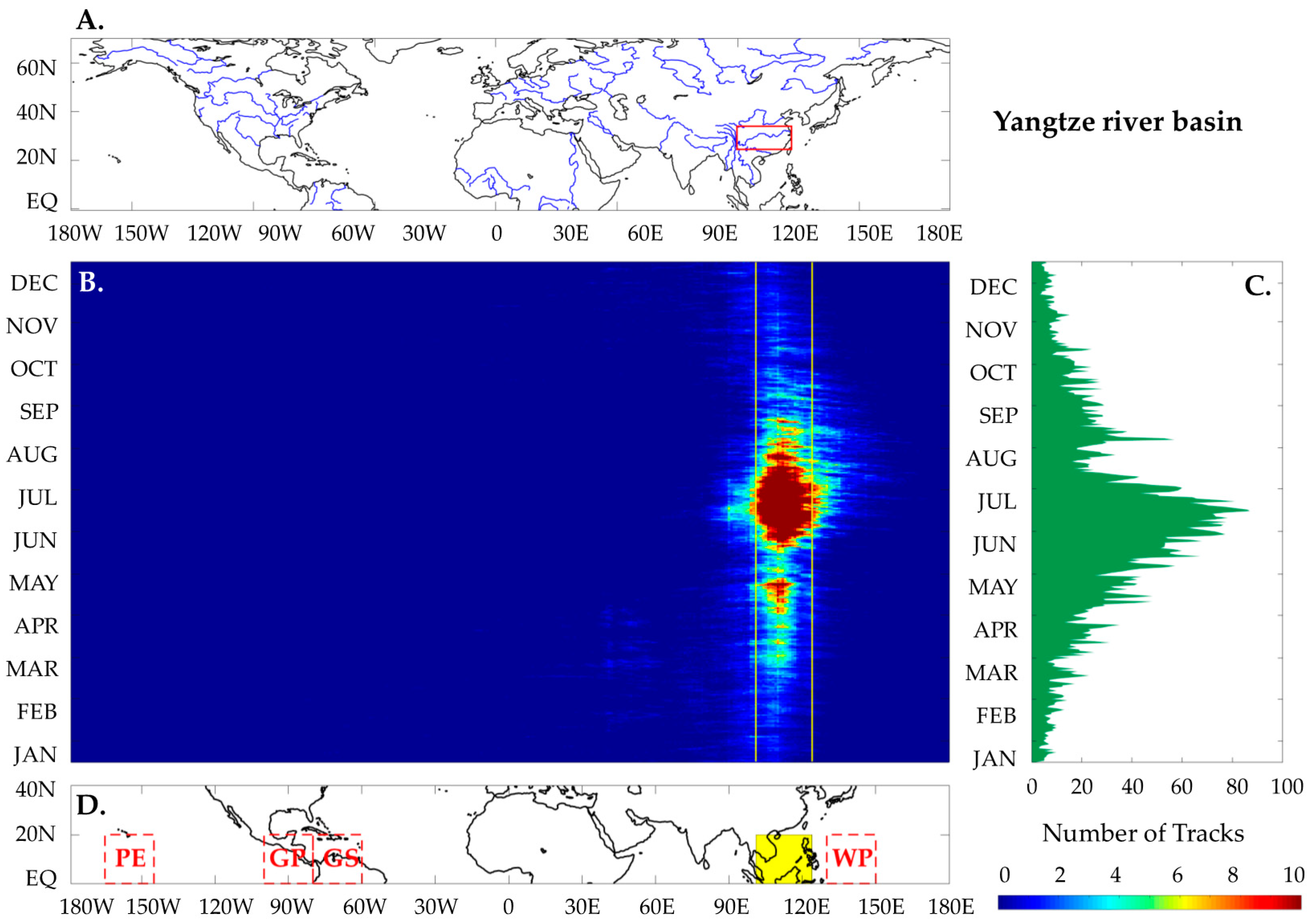
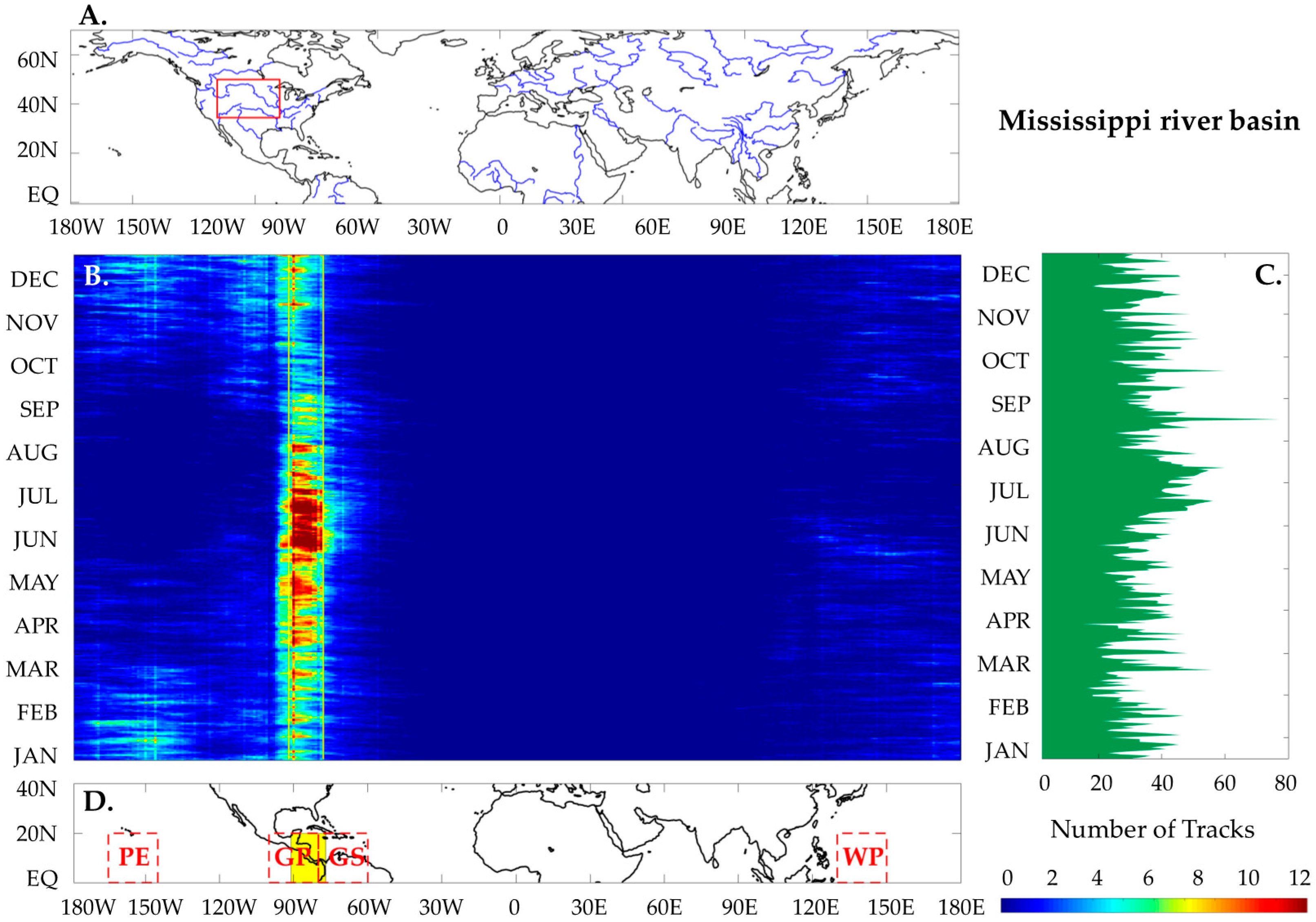
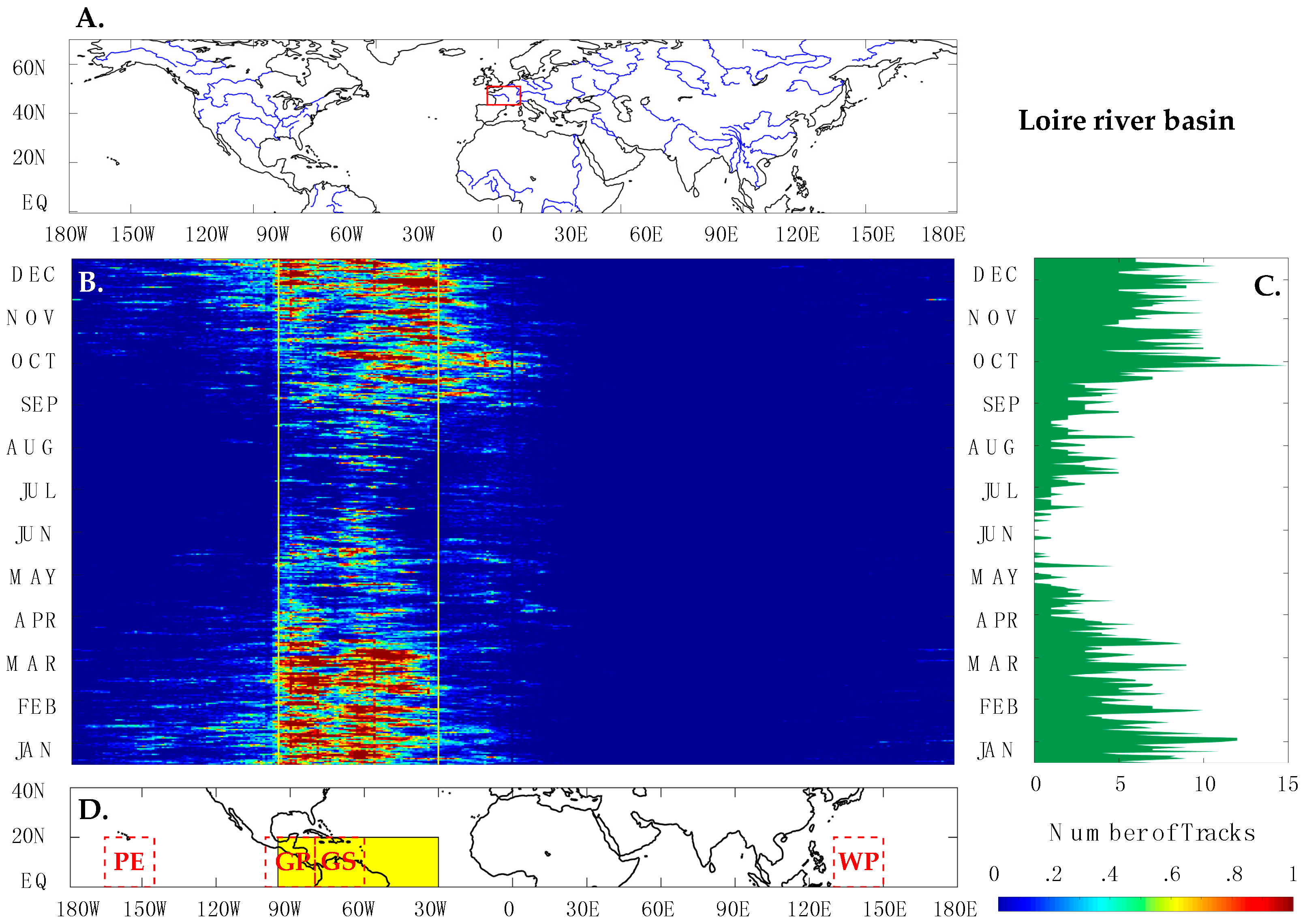
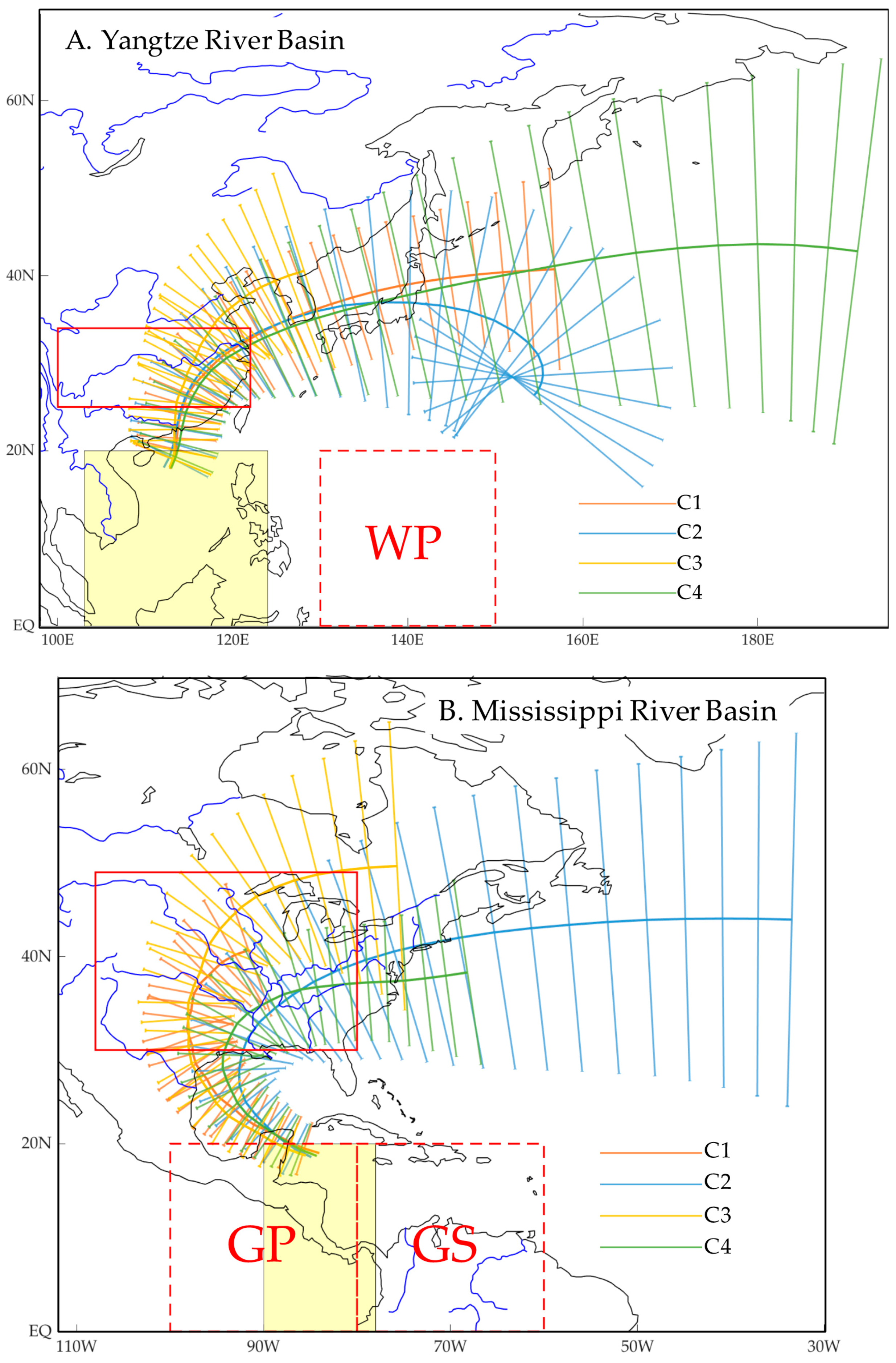
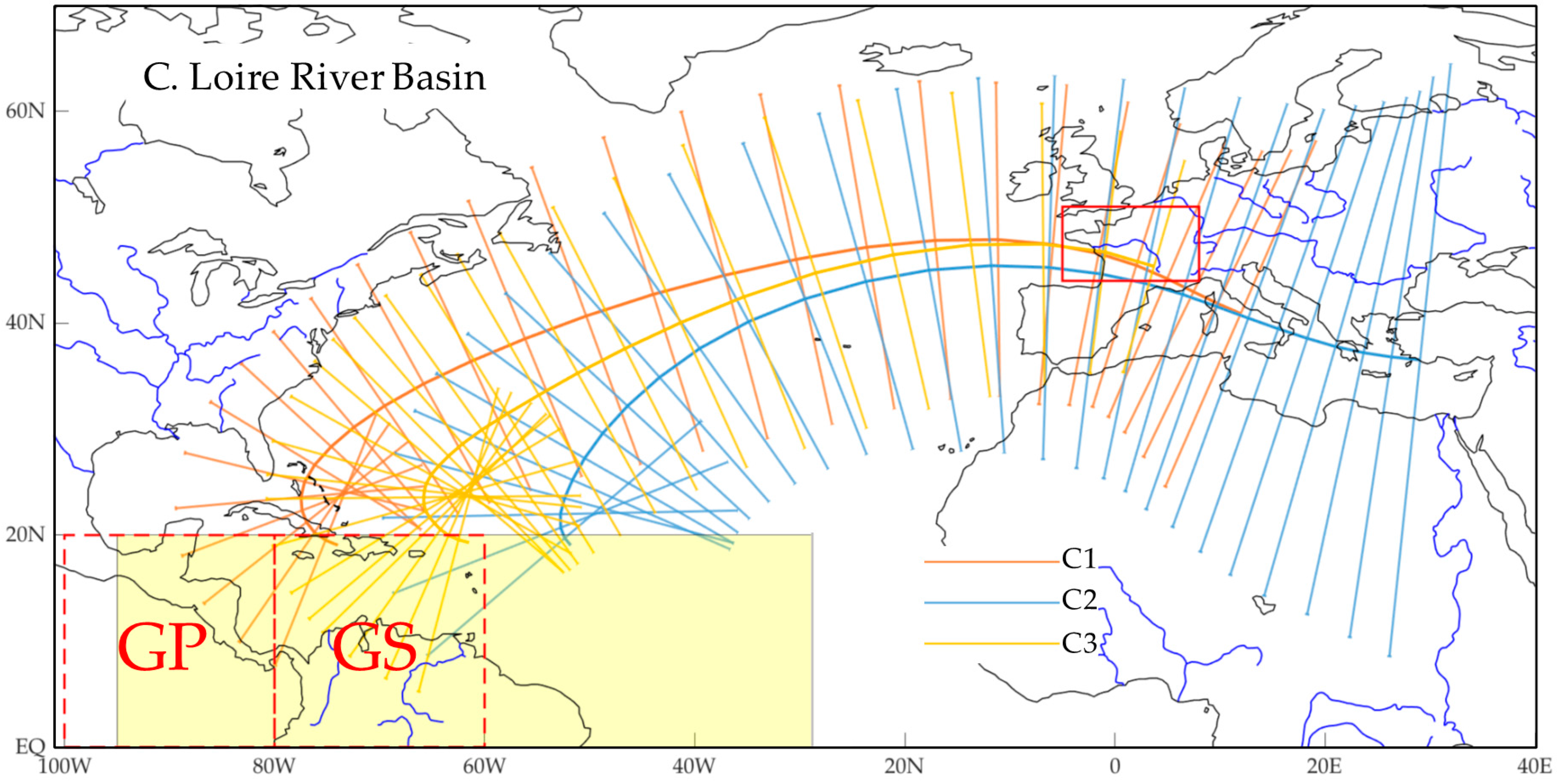

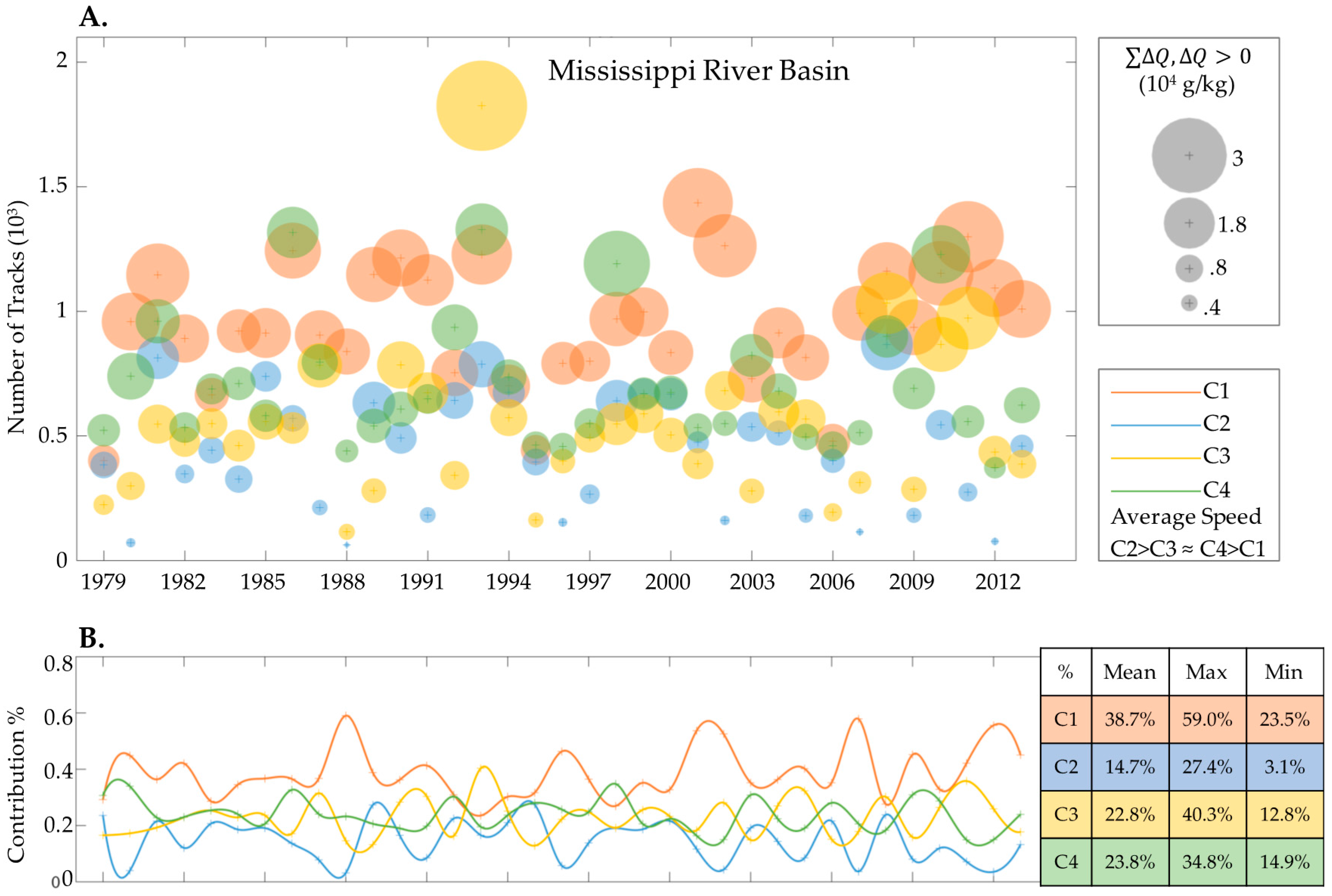
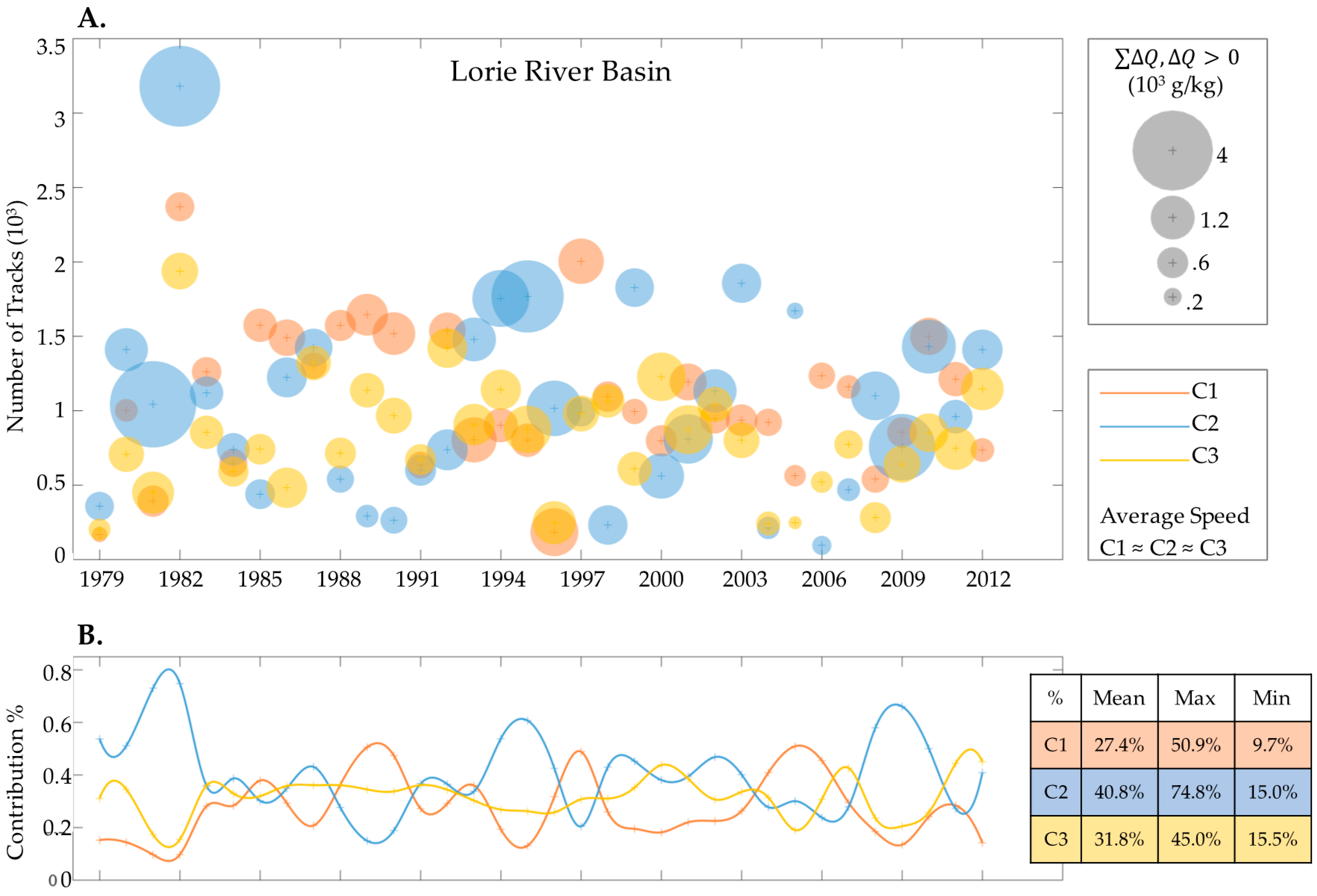

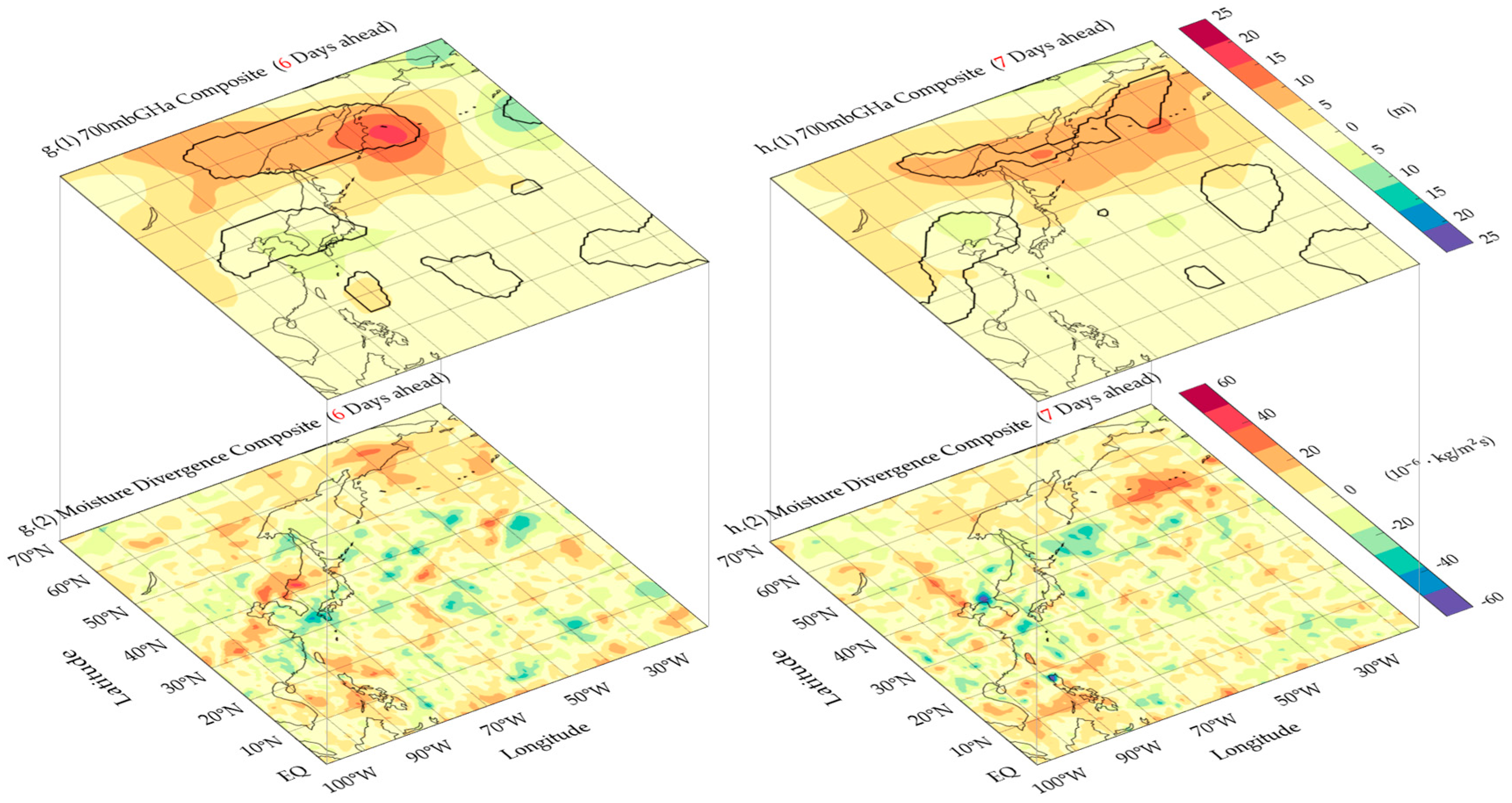
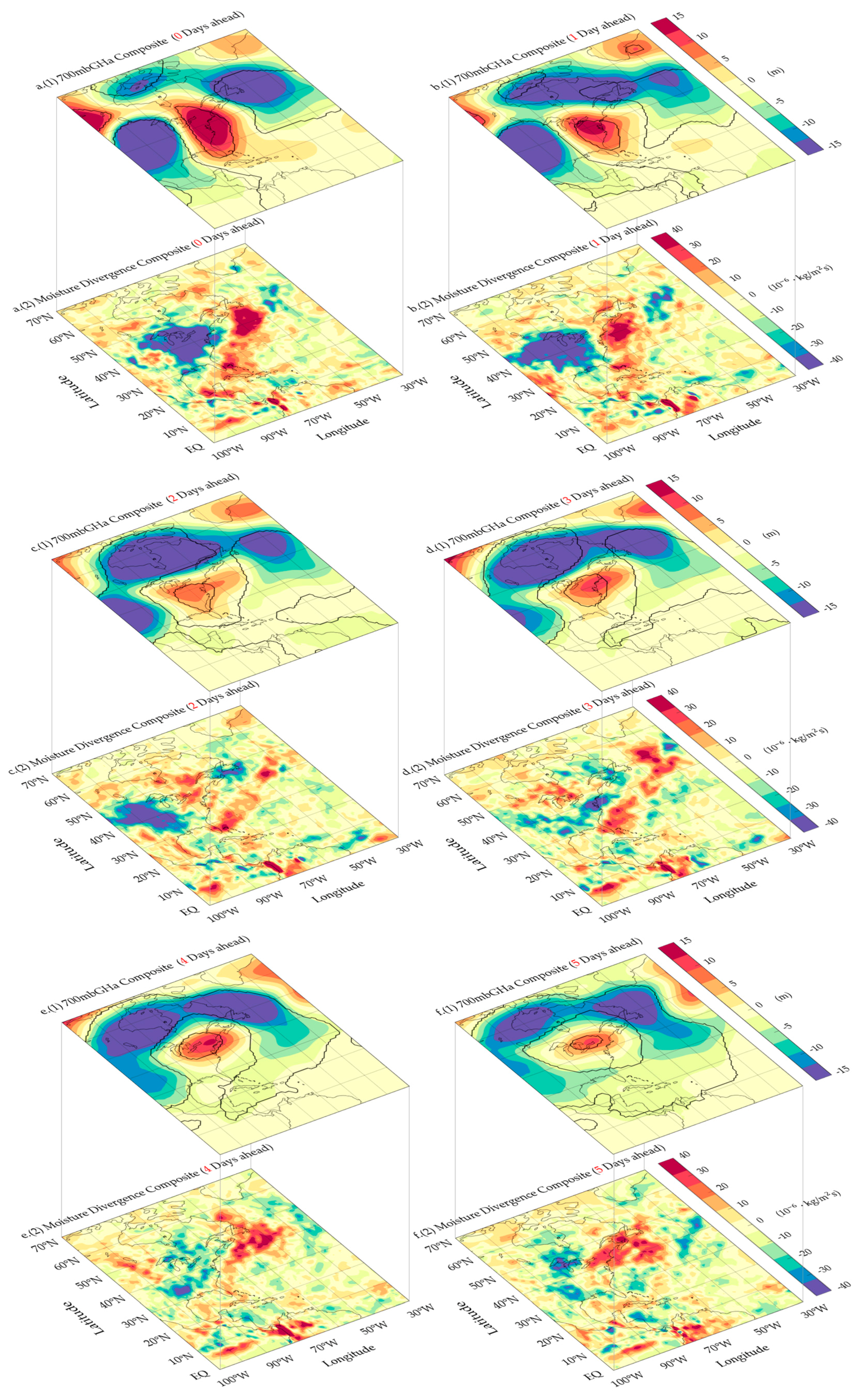


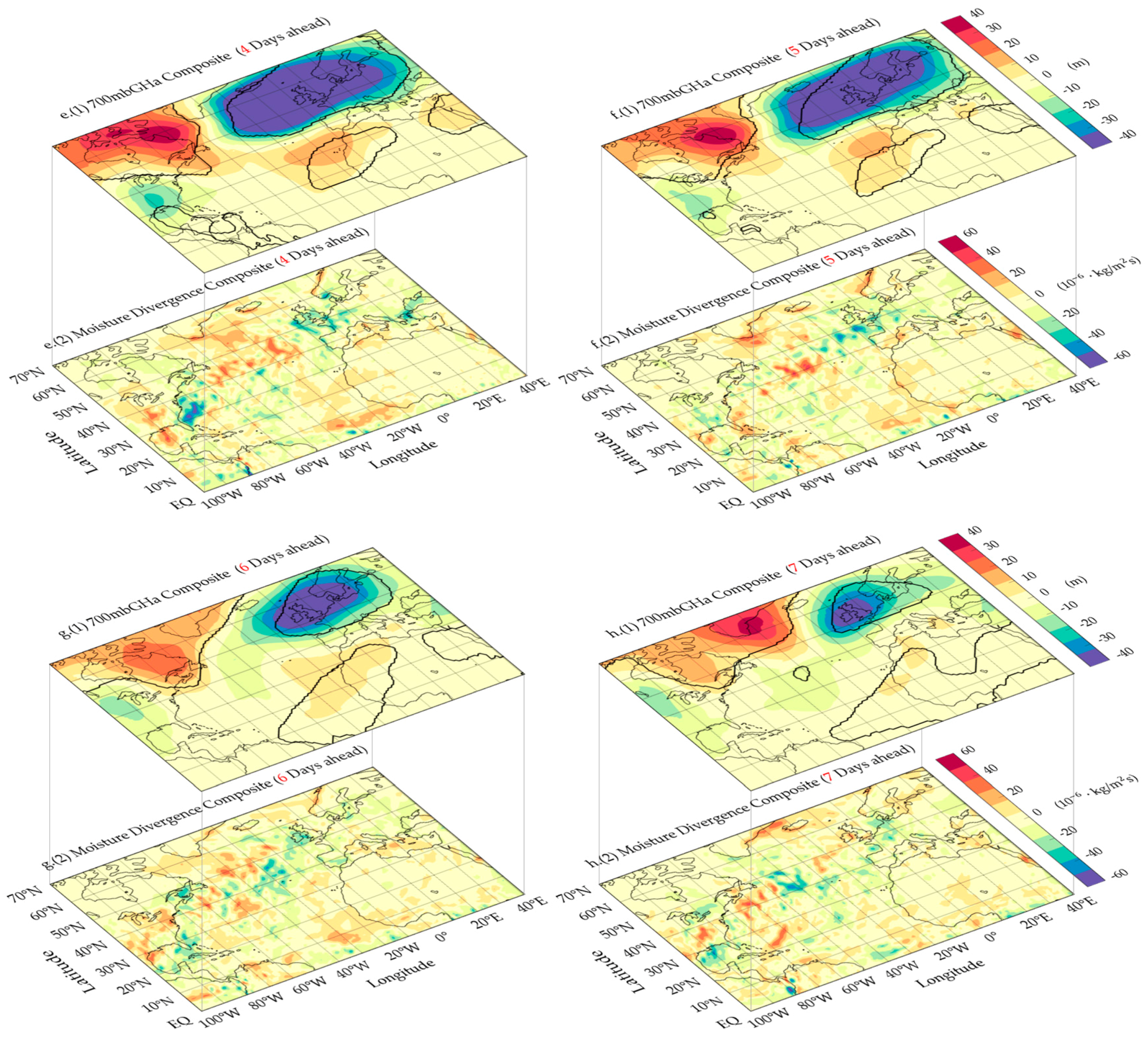
| River | Area Boundary | Main Source Region | Peak Season | Cluster # |
|---|---|---|---|---|
| Yangtze | [25–34° N, 100° E–122° E] | [0–20° N, 103° E–124° E] | Jul.–Aug. | 4 |
| Mississippi | [30–49° N, 108° W–80° W] | [0–20° N, 90° W–78° W] | Jun.–Jul. | 4 |
| Loire | [44–51° N, 5° W–8° E] | [0–20° N, 93° W–30° W] | Dec.–Jan. | 3 |
© 2017 by the authors. Licensee MDPI, Basel, Switzerland. This article is an open access article distributed under the terms and conditions of the Creative Commons Attribution (CC BY) license (http://creativecommons.org/licenses/by/4.0/).
Share and Cite
Lu, M.; Hao, X. Diagnosis of the Tropical Moisture Exports to the Mid-Latitudes and the Role of Atmospheric Steering in the Extreme Precipitation. Atmosphere 2017, 8, 256. https://doi.org/10.3390/atmos8120256
Lu M, Hao X. Diagnosis of the Tropical Moisture Exports to the Mid-Latitudes and the Role of Atmospheric Steering in the Extreme Precipitation. Atmosphere. 2017; 8(12):256. https://doi.org/10.3390/atmos8120256
Chicago/Turabian StyleLu, Mengqian, and Xiaotian Hao. 2017. "Diagnosis of the Tropical Moisture Exports to the Mid-Latitudes and the Role of Atmospheric Steering in the Extreme Precipitation" Atmosphere 8, no. 12: 256. https://doi.org/10.3390/atmos8120256





